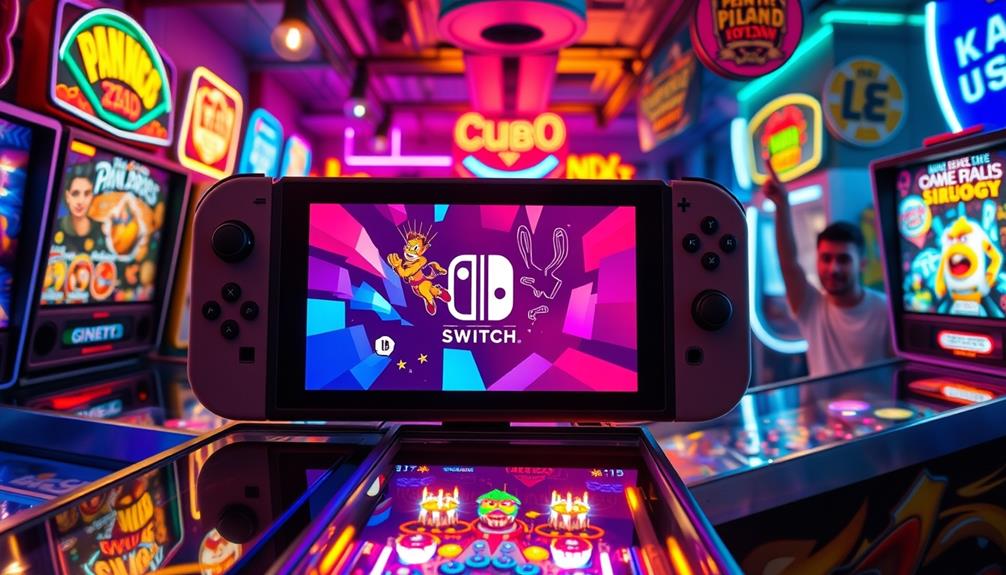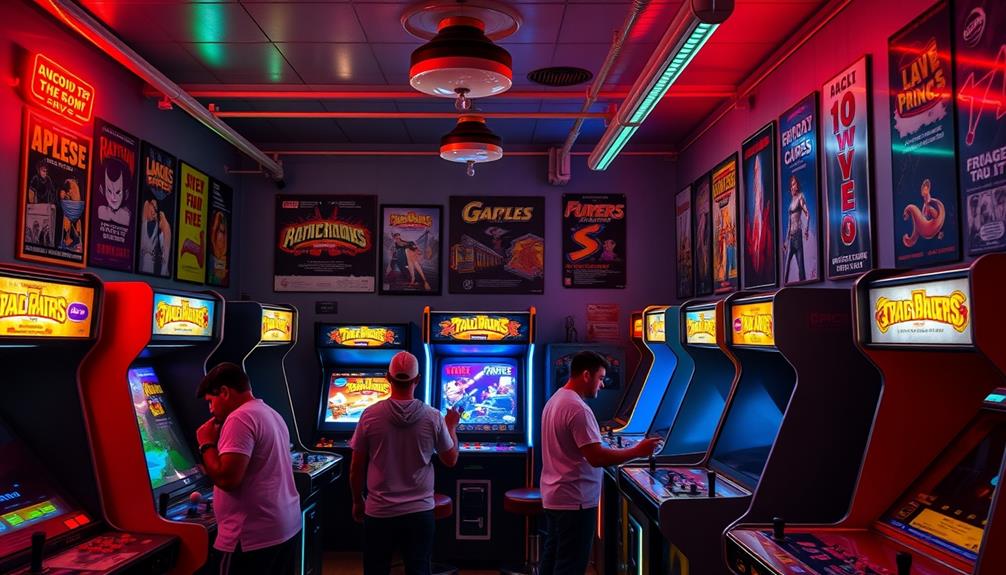If you are searching for the top operating systems for virtual pinball, I have identified three that excel in this area. Firstly, Windows offers robust support and works well with most virtual pinball software. Secondly, Linux presents a lightweight option that prioritizes performance and stability. Lastly, a specialized arcade OS such as PinballX guarantees an immersive user interface and customizable features for dedicated enthusiasts. Each of these systems has its own advantages and specific requirements, so it is important to select one based on your setup and preferences. Stay with me, and I will provide further insights to assist you in making the best decision! When choosing the right operating system, consider compatibility with the best virtual pinball software to ensure a seamless experience. Many of these programs are optimized for specific systems, so aligning your OS choice with the software’s requirements is crucial. Additionally, evaluating factors such as hardware capabilities, ease of updates, and community support can help you achieve the most enjoyable and reliable setup for your virtual pinball machine.
Key Takeaways
- Windows 10 and Windows 11 offer extensive compatibility with popular virtual pinball software, ensuring optimal performance and frequent updates.
- Linux distributions like Ubuntu provide lightweight options with community support, allowing customization for enhanced gaming experiences.
- macOS is user-friendly, with a stable environment for running virtual pinball software, albeit with limited compatibility compared to Windows.
- An SSD is crucial for all operating systems to ensure quick loading times and improved overall performance in virtual pinball games.
- Community forums for each OS enhance troubleshooting and provide access to user-generated content, improving the overall pinball experience.
Fosiya LED Arcade Joystick Buttons Kit for Video Games

If you're diving into the world of virtual pinball and want an immersive arcade experience, the Fosiya LED Arcade Joystick Buttons Kit is an excellent choice for enhancing your setup. This kit comes with everything you need: two 5-pin arcade joysticks, two USB encoders, and 20 LED push buttons for single or two-player games. The quality is impressive, featuring heat-resistant plastic and eco-friendly metal, ensuring durability. I appreciate the 8-way joystick control and the vibrant LED lighting that adds flair to my gaming experience. Installation's a breeze with plug-and-play instructions, although I noticed some users had issues with button sizes. Overall, it's a solid investment for anyone looking to elevate their arcade gaming.
Best For: Gamers looking to enhance their home arcade setup with reliable and visually appealing components.
Pros:
- Easy plug-and-play installation allows for quick setup and use.
- Vibrant LED lighting enhances the visual appeal of arcade machines.
- Durable materials ensure long-lasting performance in gaming environments.
Cons:
- Some users report quality issues with joysticks becoming loose over time.
- Button size and depth may not fit all cabinet designs, causing installation challenges.
- Mixed durability feedback, with some buttons failing after a few months of use.
MEAN WELL LRS-350-24 350.4W 24V 14.6 Amp Single Output Switchable Power

The MEAN WELL LRS-350-24 is an exceptional choice for anyone seeking reliable power for their virtual pinball setups. With a robust output of 350.4W at 24V and 14.6A, it guarantees your components run smoothly. I love the switchable AC input range, which allows me to adapt to different environments easily. Its compact dimensions of 8.46 x 1.18 x 4.53 inches make installation straightforward, and at just 1.64 pounds, it's lightweight yet durable. The built-in fan keeps things cool, while multiple protections against overload and short circuits give me peace of mind. Plus, with a solid three-year warranty, I know I'm investing in a power supply that'll last. This unit is truly a game-changer in my virtual pinball experience.
Best For: The MEAN WELL LRS-350-24 is best for hobbyists and professionals looking for a reliable and efficient power supply for virtual pinball machines and other electronic projects.
Pros:
- High power output of 350.4W at 24V ensures smooth operation of demanding components.
- Multiple protection features such as overload and short circuit protection enhance safety.
- Compact and lightweight design makes installation easy and convenient in various setups.
Cons:
- Fan noise may be noticeable in quiet environments.
- Switchable AC input range might be confusing for some users unfamiliar with power supplies.
- Limited to one output, which may not suit setups requiring multiple power outputs.
Skytech Gaming PC Desktop with Intel Core i7 and NVIDIA RTX 4070 Ti

For anyone looking to plunge into the world of virtual pinball, the Skytech Gaming PC Desktop with Intel Core i7 and NVIDIA RTX 4070 Ti stands out as an excellent choice. With its Intel Core i7 12700F processor and a powerful NVIDIA GeForce RTX 4070 Ti graphics card, you'll experience stunning visuals and smooth gameplay. The 1TB NVME SSD guarantees lightning-fast load times, while 16GB of DDR4 RAM keeps everything running seamlessly. Plus, the sleek Skytech Azure Gaming Case adds a touch of style. With great cooling solutions and a solid warranty, this setup is perfect for virtual pinball and gaming at ultra settings. It's easy to set up, and you'll appreciate the lifetime technical support.
Best For: Gamers and mid-range PC users seeking high performance and productivity capabilities in their desktop setup.
Pros:
- High-performance hardware with Intel Core i7 and NVIDIA RTX 4070 Ti for smooth gameplay at ultra settings.
- Fast storage with 1TB NVME SSD ensures quick load times and efficient multitasking.
- Lifetime technical support and a solid warranty provide peace of mind for users.
Cons:
- Some users reported issues with Windows registration and component quality.
- Not ideal for those wanting specific brand components or custom builds.
- Limited upgrade options due to pre-built configurations.
Factors to Consider When Choosing an Operating System for Virtual Pinball

When I'm choosing an operating system for virtual pinball, there are several key factors I consider. Compatibility with software, performance and speed, and user interface design all play a vital role in my decision. Plus, I can't overlook hardware requirements and the availability of community support, as these elements can really impact my overall experience.
Compatibility With Software
Choosing the right operating system for virtual pinball is vital to guarantee a superior gaming experience. First and foremost, I make sure the OS I choose is compatible with popular virtual pinball software like Visual Pinball and Future Pinball. Some software has specific OS requirements, and I don't want to run into any issues down the line. In addition to compatibility with virtual pinball software, I also consider the overall performance of the operating system. I look for an OS that has a good track record for stability and smooth gameplay. This is especially important when running multiple programs simultaneously while playing virtual pinball. Considering these factors, I can make an informed decision and select the best virtual pinball PCs to ensure an optimal gaming experience.
I also check that the operating system supports the necessary drivers for arcade controllers and LED lighting systems. These components are essential for achieving that authentic pinball feel. Additionally, I look for community support and forums related to the OS. These resources can be incredibly helpful for troubleshooting and optimizing my virtual pinball setup.
It's important to take into account the OS's ability to handle multiple instances of pinball tables, as this can demand higher resource management. Finally, I prefer an operating system that provides regular updates. This guarantees compatibility with the latest software versions and keeps my system secure. By focusing on these compatibility factors, I can enjoy an immersive and seamless virtual pinball experience.
Performance and Speed
After ensuring compatibility with software, I focus on performance and speed, which are just as important for a smooth virtual pinball experience. The operating system's ability to efficiently utilize hardware resources, especially the CPU and GPU, plays a vital role here. A lightweight operating system can greatly improve speed by minimizing resource overhead, enabling higher frame rates and quicker response times during gameplay.
When selecting an OS, I also consider its compatibility with various pinball simulation software. This can impact overall performance and the ability to run multiple tables simultaneously without lag. Systems that come with optimized drivers and support for modern hardware tend to enhance performance, particularly in rendering high-resolution graphics—essential for an immersive experience.
I can't overlook the importance of regular updates and community support for the operating system. These updates can deliver important bug fixes and enhancements, ensuring that the system remains smooth over time. In my experience, prioritizing performance and speed in an operating system can make all the difference in enjoying virtual pinball to the fullest.
User Interface Design
Designing a user-friendly interface is essential for an enjoyable virtual pinball experience. I've found that a well-thought-out layout greatly enhances user engagement, allowing players to smoothly navigate through game options and settings. When choosing an operating system, I always prioritize accessibility; clearly labeled buttons and controls are important, especially for accommodating both novice and experienced players.
I also believe that incorporating vibrant graphics and animations makes the interface visually appealing and exciting during gameplay. A colorful, dynamic interface can draw players in and keep them engaged. Consistency in design elements, such as color schemes and iconography, helps create a cohesive user experience. This familiarity allows players to quickly adapt to the system, which is critical for maintaining that immersive feel.
Lastly, responsive feedback mechanisms, like sound effects or visual cues, enhance player interaction with the virtual pinball environment. I've noticed that these elements contribute greatly to the overall enjoyment of the game, making every flick of the flipper feel impactful. By focusing on these factors, you can guarantee that your virtual pinball experience is not just functional but truly enjoyable.
Hardware Requirements
An enjoyable virtual pinball experience goes beyond just a well-designed interface; it also hinges on the right hardware to support that experience. First off, you'll need a 64-bit operating system to effectively utilize modern multi-core processors and more than 4 GB of RAM. This guarantees that the software runs smoothly without lag. A dedicated graphics card with at least 2 GB of VRAM is essential, as it allows for high-quality visuals and effects that truly bring the game to life.
Next, consider your storage options. An SSD is preferable for quick loading times, which can greatly enhance your overall gaming performance. You'll also want a minimum of 8 GB of RAM for ideal multitasking. This way, you can run virtual pinball applications alongside other software without any hiccups.
Community Support Availability
How important is community support when selecting an operating system for virtual pinball? It's absolutely vital. When I look for an OS, I focus on the availability of active forums and user groups. These communities provide essential troubleshooting assistance and share custom configurations that can save me a lot of time and frustration.
A strong community means I have access to a treasure trove of user-generated content, from tutorials to guides and modifications. These resources can greatly enhance my virtual pinball experience, making it more enjoyable and immersive.
Operating systems with larger user bases often receive more frequent updates and patches, thanks to community feedback. This is something I always keep in mind, as it shows that the developers are engaged and responsive.
Moreover, dedicated online communities can lead to the development of plugins and additional features that take gameplay to the next level. Finally, having access to FAQs and shared experiences can reduce the learning curve for new users like me, making the change smoother and more enjoyable. So, don't underestimate the value of community support when choosing your virtual pinball OS!
Customization Options
Customization options play an essential role in shaping my virtual pinball experience. When I choose an operating system, I look for the ability to adjust game physics, visual effects, and table layouts. These elements greatly enhance gameplay and make each session feel unique. One of the standout features is the ability to create and import custom tables, allowing me to flex my creativity and design my dream pinball machine.
I also appreciate the flexibility to modify controller settings and button mappings. This personal touch guarantees that I have the best control during gameplay, which can be vital in high-stakes moments. For those of us who enjoy diving deeper, some operating systems support scripting languages. This means I can create unique game rules and features that truly personalize my experience.
Additionally, I love the option to integrate third-party software. Whether it's enhanced sound effects or lighting controls, these additions create an immersive atmosphere that keeps me coming back for more. Ultimately, the level of customization an operating system offers can make a substantial difference in how I enjoy virtual pinball.
Stability and Reliability
When setting up my virtual pinball experience, I can't overlook the importance of stability and reliability in the operating system I choose. A stable OS guarantees smooth gameplay and responsiveness, which is essential for avoiding crashes or performance hiccups during intense sessions. I've found that opting for long-term support (LTS) versions often pays off, as they maintain system integrity over time, especially under demanding conditions.
Frequent updates and a robust support community are also key factors. They not only provide necessary patches for bugs and security vulnerabilities but also offer peace of mind when I'm gaming. Compatibility with existing software and drivers can't be neglected either; it's critical for seamless integration of emulators and control interfaces in my setup.
Lastly, I always check user feedback and testing from communities. Insights from real-world scenarios help me gauge the reliability of different operating systems. By prioritizing stability and reliability, I can focus on enjoying the game rather than worrying about system performance. Overall, choosing the right OS can greatly enhance my virtual pinball experience.
Frequently Asked Questions
Can I Use My Existing Computer for Virtual Pinball Setup?
Absolutely, I've used my existing computer for virtual pinball setups. Just guarantee it meets the necessary specifications for smooth gameplay, and you'll have a fantastic experience without needing to invest in new hardware.
What Hardware Specifications Are Ideal for Virtual Pinball?
When I think of virtual pinball's vibrant lights and immersive sounds, I realize ideal hardware needs a fast processor, ample RAM, and a dedicated graphics card. These elements guarantee smooth gameplay and stunning visuals, enhancing the experience.
Are There Any Free Operating Systems for Virtual Pinball?
Absolutely, I've found several free operating systems that work great for virtual pinball. Linux distributions, like Ubuntu or RetroPie, offer fantastic performance and flexibility, making them ideal choices for my virtual pinball setup.
How Do I Troubleshoot Common Virtual Pinball Software Issues?
When I troubleshoot virtual pinball software issues, I check for updates, verify configurations, and review error messages. If problems persist, I consult forums for solutions and connect with the community for tips and advice.
Is Online Multiplayer Available in Virtual Pinball Games?
When I first played virtual pinball, I was amazed by the online multiplayer options. Yes, many virtual pinball games offer multiplayer modes, letting you challenge friends or players worldwide. It's a blast to compete!
Conclusion
In the grand arcade of life, choosing the right operating system for virtual pinball is like picking the perfect joystick to guide your ball. Each OS offers its own unique playfield, with features that can either elevate your game or leave you stuck in a tilt. By understanding your needs and the strengths of each option, you can steer your experience toward a high score, ensuring your virtual adventures are as thrilling as the real deal.








